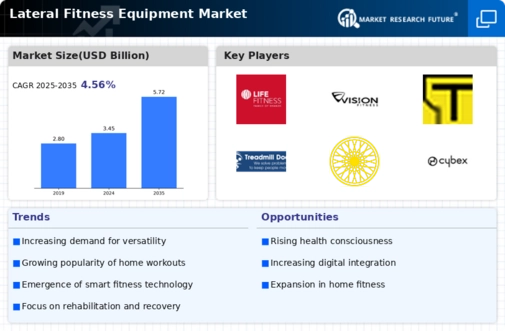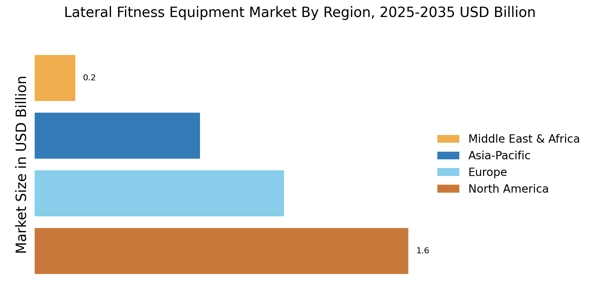Technological Advancements
Technological advancements play a pivotal role in shaping the Lateral Fitness Equipment Market. The integration of smart technology into fitness equipment has transformed the user experience, making workouts more engaging and effective. Features such as real-time performance tracking, personalized workout plans, and interactive training sessions are becoming increasingly prevalent. This trend is supported by data indicating that approximately 30% of fitness enthusiasts prefer equipment with integrated technology. As manufacturers continue to innovate, the Lateral Fitness Equipment Market is likely to see an influx of products that cater to tech-savvy consumers, enhancing their workout experiences and driving sales.
Increasing Health Awareness
The Lateral Fitness Equipment Market is experiencing a surge in demand driven by a growing awareness of health and fitness among consumers. As individuals become more conscious of the importance of physical activity in maintaining overall well-being, the inclination towards lateral fitness equipment has intensified. This trend is reflected in the rising participation rates in fitness activities, with a notable increase in gym memberships and home fitness equipment purchases. According to recent data, the fitness equipment market has seen a compound annual growth rate of approximately 4.5%, indicating a robust interest in fitness solutions. The Lateral Fitness Equipment Market is poised to benefit from this heightened focus on health, as consumers seek innovative and effective ways to incorporate exercise into their daily routines.
Focus on Functional Training
The Lateral Fitness Equipment Market is significantly influenced by the rising focus on functional training. This training approach emphasizes exercises that mimic everyday movements, enhancing overall strength and stability. As fitness enthusiasts increasingly seek workouts that improve their functional capabilities, lateral fitness equipment has gained traction. Industry expert's indicates that functional training equipment sales have increased by approximately 15% in recent years. This trend suggests that consumers are prioritizing equipment that offers versatility and effectiveness in their training regimens. Consequently, the Lateral Fitness Equipment Market is likely to thrive as it aligns with the growing demand for functional training solutions.
Rise of Home Fitness Solutions
The Lateral Fitness Equipment Market is witnessing a notable shift towards home fitness solutions. With the increasing popularity of at-home workouts, consumers are investing in lateral fitness equipment that can be easily integrated into their living spaces. This trend is underscored by market data showing that sales of home fitness equipment surged by over 25% in the past year. The convenience of exercising at home, coupled with the desire for privacy and flexibility, has led to a growing demand for lateral fitness equipment. As more individuals prioritize home fitness, the Lateral Fitness Equipment Market is expected to expand, offering a diverse range of products tailored for home use.
Expansion of Fitness Facilities
The expansion of fitness facilities is a key driver for the Lateral Fitness Equipment Market. As new gyms and fitness centers emerge, there is a corresponding demand for a diverse range of fitness equipment, including lateral fitness solutions. Recent statistics indicate that the number of fitness facilities has increased by over 10% in the last two years, reflecting a robust interest in fitness culture. This growth presents opportunities for manufacturers and suppliers within the Lateral Fitness Equipment Market to cater to the evolving needs of fitness facilities. As these establishments seek to offer comprehensive training options, the demand for lateral fitness equipment is expected to rise, further propelling market growth.


















Leave a Comment